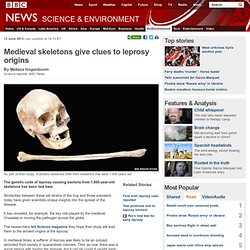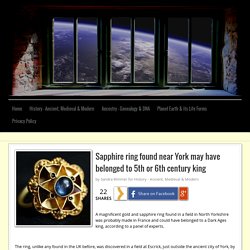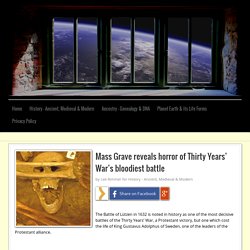

Soil samples show Richard III suffered from roundworm. 3 September 2013Last updated at 20:53 ET By Melissa Hogenboom Science reporter, BBC News Soil from the pelvis area of Richard III's skeleton had many roundworm eggs Richard III suffered from a roundworm infection, a team says.

A soil sample from the region where his infected intestines would have been during life, revealed multiple roundworm eggs. Prevalent both in medieval times and in tropical countries today, the roundworm parasite spreads from faecal contamination and can grow up to one foot long. In addition to soil from the pelvis, scientists tested soil from other areas of the grave to see whether the eggs were equally distributed. Readings in Early English. Readings in Early English - Old English Texts. Anno 449.

In this year [lit here] Martianus and Valentinus succeeded to [lit received] kingship, and ruled seven years. Anglo-Saxon Chronicle. The compared versions below clearly show that it would be a mistake to treat the ASC as if it were just one chronicle, one single MS, that supposedly was added to over the centuries.

It is believed that during the 9th century a chronicle was drawn up in Wessex, probably due to King Alfred. Some of the sources used to compile this chronicle have been identified: Bede's Historia Ecclesiastica Gentis Anglorum, and its chronological summary which is continued down to Ecgbryht (Egbert); several Northumbrian and Mercian king-lists; etc. Other (non-extant) sources have been suggested for other material in the chronicles, for example an earlier set of West Saxon annals down to 754 have been postulated to account for the relative frequency of West Saxon references to this point.
There are very few (just 5) entries between 755 and 823 that refer specifically to Wessex, and these are thought to come from an oral tradition. Old english anglo saxon. Medieval skeletons give clues to leprosy origins. 13 June 2013Last updated at 14:10 ET By Melissa Hogenboom Science reporter, BBC News.

The Mary Rose: A Tudor ship's secrets revealed. By Eleanor Williams BBC News.

The Mary Rose: A Tudor ship's secrets revealed. Real King of England dies in Australia – the true royal lineage which would have changed British history. The recent death of 71-year-old Mike Hastings in a quiet town in New South Wales highlights the genetic lottery of monarchy and how dynastic fortunes hang by a thread. The unassuming Mr Hastings, who had worked variously as a forklift driver, a door-to-door encyclopaedia salesman and an agronomist, shot to fame in 2004 when he was tracked down by actor Tony Robinson for the Channel 4 documentary, Britain’s Real Monarch.
The genealogical research presented by the documentary provided strong evidence that Mike Hastings should rightfully have been: His Majesty Michael I, by the Grace of God of the United Kingdom of Great Britain and Northern Ireland and of His Other Realms and Territories King, Head of the Commonwealth, Defender of the Faith . His claim to the throne, which he cheerfully rejected when he discovered it, goes back to medieval England and the reign of King Edward IV .
Sapphire ring found near York may have belonged to 5th or 6th century king. A magnificent gold and sapphire ring found in a field in North Yorkshire was probably made in France and could have belonged to a Dark Ages king, according to a panel of experts.

The ring, unlike any found in the UK before, was discovered in a field at Escrick, just outside the ancient city of York, by a metal detectorist in 2009. It measures 2.5cm across and is intricately made of gold, prestige glass and a large sapphire. It was originally thought to be a 10th or 11th century bishop’s ring when it was bought by the Yorkshire Museum for £35,000 ($52,000). However, a panel of 30 experts from across the UK has concluded that it is far older, probably dating to the 5th or 6th century, and historically more important.
Mass Grave reveals horror of Thirty Years’ War’s bloodiest battle. The Battle of Lützen in 1632 is noted in history as one of the most decisive battles of the Thirty Years’ War, a Protestant victory, but one which cost the life of King Gustavus Adolphus of Sweden, one of the leaders of the Protestant alliance.

However, the human reality of the battle on that wintry day in 16 November, however, has been captured by der Spiegel Online‘s haunting pictures of an excavated mass grave from the site of the battlefield near Leipzig, Germany. Maik Reichel, head of the Lützen museum, told der Spiegel, “In this battle the only rule that applied was, ‘him or me’. It was better to stab your opponent one extra time just to ensure there was no chance of him standing up again. About 20,000 men fought on each side and between 6,000 and 9,000 were killed.” Culture - Early German art: Defined by contradictions.
Carbon test hopes for 'Battle of Lewes casualty' 30 April 2013Last updated at 11:50 ET The skull has sword wounds and a large number of blows to the head Tests are under way on a skeleton found in an East Sussex town to find out if it is a victim of the 1264 Battle of Lewes.

Lewes is gearing up for celebrations next year to mark the 750th anniversary of the battle between the armies of King Henry III and Simon de Montfort. York University experts are testing bones thought to be those of a soldier. Sussex Archaeological Society said the skeleton could take centre stage in next year's anniversary celebrations. Burial question Continue reading the main story. Richard III Scoliosis: King May Have Had Painful Spine Treatments, Archaeologists Say. By: Jeanna Bryner, LiveScience Managing Editor Published: 04/19/2013 09:42 AM EDT on LiveScience King Richard III may not have been a hunchback as portrayed by Shakespeare, but he did suffer from the spine-curving condition scoliosis, and he may have undergone painful medical treatments to straighten it out, scientists report today (April 19).

Ffee and qahwa: How a drink for Arab mystics went global. 17 April 2013Last updated at 20:13 ET By John McHugo Author The Arab world has given birth to many thinkers and many inventions - among them the three-course meal, alcohol and coffee.

Unearthed Scots find gives insight into Battle of Flodden. Richard III Document Signed Circa 1473 To Be Auctioned (PHOTOS) An incredibly rare document signed by Richard III of England is set to be auctioned, and it's expected to fetch up to $125,000. The document, which dates to about 1473 and is signed "R. Gloucestre," is a record of Richard, then Duke of Gloucestershire, intervening in a dispute between a landowner and his tenants. (Click fullscreen for best experience. Story continues below) Loading Slideshow This image provided by Nate D. Richard III Signed Document Auctioned. 'King Alfred The Great' Bones Exhumed From Winchester Church Over Vandalism Fears. Bones that could belong to King Alfred the Great have been exhumed from a churchyard over fears that they might be stolen or vandalised. Archaeologists carried out the exhumation of an unmarked grave at St Bartholomew's Church in Winchester, Hampshire, this morning on church orders.
There has been speculation the bones of the legendary 9th-century king - who is said to have burnt the cakes and defeated the Danes - could be buried there and the church felt there was a heightened risk of theft. 'Black Death pit' unearthed by Crossrail project. By Jason Palmer Science and technology reporter, BBC News. Richard III tomb plans revealed by Leicester cathedral. Medieval knight remains found in Edinburgh car park - Heritage. THE remains of a medieval knight have been discovered underneath a car park that is being demolished at a city-centre building site. Reconstructing Richard III: the man behind the myth. Mar 08, 2013 Featured, Richard III 1. Treachery: What really brought down Richard III. Richard the Lionheart's mummified heart analysed. 28 February 2013Last updated at 09:04 ET By Rebecca Morelle Science reporter, BBC World Service.
'Downton' house could unlock secrets of Surrey history. 23 February 2013Last updated at 03:17 ET. Greco-Egyptian Alchemy in Byzantium (Study)